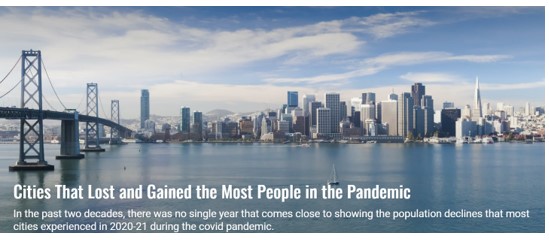Most American Cities In Decline – This Should Not Be News
It seems in recent months the mainstream media is finally waking up to the fact that many of America’s large cities are in decline and have been trending that way for years. Crime is up significantly in most cities, and voters are revolting over the lack of public order in their streets.
Left-leaning politicians are realizing their liberal policies, including such things as “defunding the police,” have not worked, although few will admit it. Angry voters are convincing them they will have to change their ways going forward. The question is: How?

Later this year, Philadelphians will head to the polls in a race where public safety will likely be the decisive issue. New Orleans mayor LaToya Cantrell faces a possible recall election due to high crime rates. In St. Louis, progressive mayor Tishaura Jones faces a push by Missouri lawmakers to wrest control of her city’s police department from her and put it in the hands of the governor.
The most high-profile showdown over crime so far this year was in Washington, DC, where the city council has pushed through a rewriting of the city’s crime bill against the wishes of the mayor, Muriel Bowser. The legislation would soften sentences for serious and violent crimes — and do so at a time when things seem to be spiraling out of control.
This local row took on national proportions when Democrats in Congress joined with Republicans to exercise their right to block the legislation. Joe Biden, having said he would veto such a move, changed his mind in early March.
At a January event, Bowser said a recent spate of killings reminded her of the crack epidemic, a time that most Washingtonians assumed was firmly in their city’s past. But with crime on the rise, some aren’t so sure. Homicides in the city were up 40% year-on-year in the first two months of 2023. Car thefts have more than doubled.
In 2021 and 2022, much was made of the Democratic Party’s retreat from the “defund the police” measures with which they flirted at the height of 2020’s “racial reckoning.” After this welcome about-turn, 2023 has so far been a sobering reminder of how much further there is to go if city leaders are to reverse the disturbing rise in violent crime.
Unfortunately, most candidates elected on the promise of reversing these trends so far have little to show for their work. New York mayor Eric Adams, an ex-cop himself, got the top job with a promise to bring crime under control. So far, it’s hard to see signs he has made any progress.
City leaders across the country are grappling with the thorny problem of police numbers. Police aren’t being actively defunded, but they are often deeply demoralized and, in many cities, their numbers have dwindled. There are 3,400 police officers in Washington, DC. The city’s chief says he needs a force of 4,200 to be at full strength. Not even a $20,000 signing bonus has managed to boost sign-up for what can be a thankless, dangerous and difficult job.
Unfortunately, crime is far from the only problem plaguing America’s cities. Three years on from the start of lockdowns, downtown office occupancy rates are shockingly low, leaving holes in city budgets, forcing surrounding businesses to shutter and posing existential questions about the purpose of some of the country’s most valuable real estate. In cities across America, homelessness has become a visible sign of growing urban decay and a top concern for voters. Public education in large American cities left a lot to be desired before the pandemic; now school systems must grapple with chronic absenteeism and learning loss.

American city dwellers deserve, at a bare minimum, a serious-minded focus on the problems that actually matter. But time and again, even that seems to be too much to ask. Consider, for instance, the priorities of officials in San Francisco: determined not to be outdone by progressives elsewhere, city leaders are weighing a proposal that would give every black San Franciscan $5 million in reparations.
Anyone interested in making American cities safer, more functional, better places to live and work comes up against a trifecta of challenges. There’s the age-old problem of powerful interest groups that try to influence city policymaking. Then there’s the identity-infused progressivism that has come to dominate in deep-blue cities — the impulse that pushes for “equity” at all costs, regardless of whether it ends up with more dangerous streets or falling standards in schools.
Finally, and relatedly, is the issue of political one-sidedness. One-party rule is not, generally speaking, a recipe for success. But that is what many Americans living in cities are stuck with. The scale of Democratic failure may finally be changing that: in last year’s midterms, even New York City Republicans showed some signs of life. But the GOP is still far from seriously competing in the politics of America’s major cities.
Ultimately, it’s hard to think the factors that so profoundly impede improvements for America’s cities are about to change. That leaves those living in them with a familiar question: “How much worse do things have to get before they get better?”
More By This Author:
Inflation Is Falling, But Maybe Not Fast Enough For Fed
Stock, Bond & Cash Returns Over The Last Century
Implications From Last Week’s Blockbuster Jobs Report



